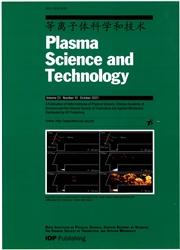非热常压正脉动电晕放电对Bi2O3催化剂催化降解纺织染料活性蓝19的影响
IF 1.8
3区 物理与天体物理
Q3 PHYSICS, FLUIDS & PLASMAS
引用次数: 0
摘要
摘要:据我们所知,单斜晶Bi2O3首次作为催化剂应用于非热常压正脉冲电晕放电降解染料的过程。研究的重点是等离子体产生的物种与催化剂的相互作用,以及它在降解过程中的作用。采用自制的反应器系统对蒽醌活性染料活性蓝19 (rb19)进行了等离子体分解。采用电沉积+热处理法制备Bi2O3,并用XRD、SEM和EDX技术对Bi2O3进行了表征。观察到催化剂促进等离子体生成的H2O2分解为主要的染料降解试剂•OH自由基,并进一步攻击染料分子。催化剂脱色率提高2.5倍,产能提高93.4%,总有机碳TOC去除率提高7.1%。催化剂的激发主要是通过等离子体产生的反应离子和来自空气的自由基的撞击,在电场的加速下,以及由飘带到达液体表面产生的能量高达15 eV的快速电子。这些撞击将能量传递给催化剂,并产生电子和空穴,这些电子和空穴与H2O2和水进一步反应,产生•OH自由基。这被认为是催化剂在这一过程中的主要作用。脱色反应遵循准一级动力学。H2O2产率和染料降解率随输入电压的增加而增加。催化剂的最佳用量为500 mg dm-3。河水中的脱色率略低于去离子水,这是由于•OH自由基与河水中溶解的有机物和无机离子的副反应。本文章由计算机程序翻译,如有差异,请以英文原文为准。
Non-thermal atmospheric pressure positive pulsating corona discharge in degradation of textile dye Reactive Blue 19 enhanced by Bi2O3 catalyst
Abstract Monoclinic Bi2O3 was applied for the first time, to the best of our knowledge, as a catalyst in a process of the dye degradation by the non-thermal atmospheric pressure positive pulsating corona discharge. The research focused on the interaction of the plasma-generated species and the catalyst, as well as its role in the degradation process. Plasma decomposition of the anthraquinone reactive dye Reactive Blue 19 (RB 19) was performed by the self- made reactor system. Bi2O3 was prepared by electrodeposition followed by thermal treatment, and characterized by XRD, SEM and EDX techniques. It was observed that the catalyst promoted decomposition of plasma-generated H2O2 into •OH radicals, the principle dye-degrading reagent, which further attacked the dye molecules. The catalyst improved the decolorization rate by 2.5 times, the energy yield by 93.4%, and the total organic carbon TOC removal by 7.1%, respectively. The excitation of the catalyst mostly occurred through the strikes of plasma-generated reactive ion and radical species from the air, accelerated by the electric field, as well as by the fast electrons with the energy of up to 15 eV, generated by the streamers reaching the liquid surface. Those strikes transferred the energy to the catalyst and created the electrons and holes which further reacted with H2O2 and water, producing the •OH radicals. This was indentified as the primary role of the catalyst in this process. Decolorization reactions followed the pseudo first order kinetics. Production of H2O2 and dye degradation rate increased with the increase of input voltage. The optimal catalyst dose was 500 mg dm-3. Decolorization rate was little lower in the river water compared to the one in deionized water due to the side reactions of •OH radicals with the organic matter and inorganic ions dissolved in the river water.
求助全文
通过发布文献求助,成功后即可免费获取论文全文。
去求助
来源期刊

Plasma Science & Technology
物理-物理:流体与等离子体
CiteScore
3.10
自引率
11.80%
发文量
3773
审稿时长
3.8 months
期刊介绍:
PST assists in advancing plasma science and technology by reporting important, novel, helpful and thought-provoking progress in this strongly multidisciplinary and interdisciplinary field, in a timely manner.
A Publication of the Institute of Plasma Physics, Chinese Academy of Sciences and the Chinese Society of Theoretical and Applied Mechanics.
 求助内容:
求助内容: 应助结果提醒方式:
应助结果提醒方式:


